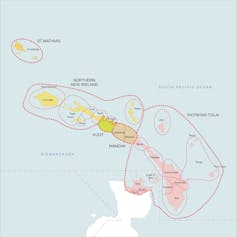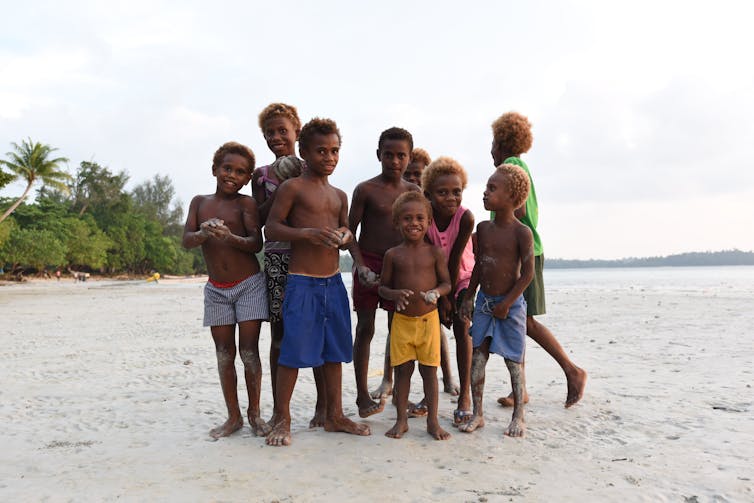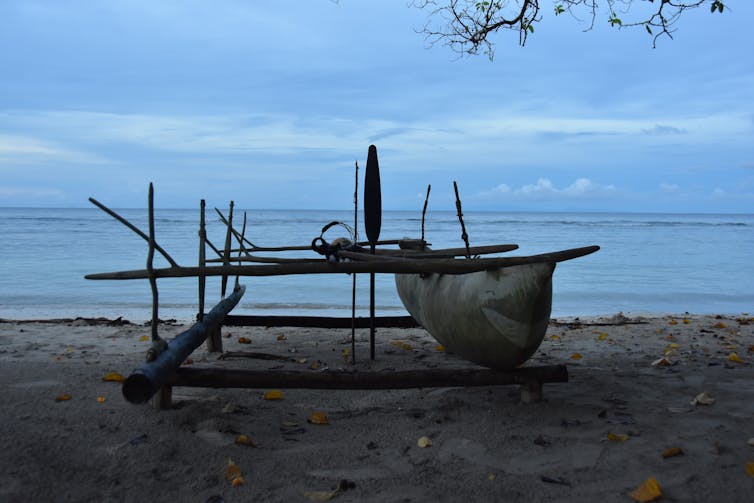Deep sea mining threatens indigenous culture in Papua New Guinea
John Childs, Lancaster University
When they start mining the seabed, they’ll start mining part of me.
These are the words of a clan chief of the Duke of York Islands – a small archipelago in the Bismarck Sea of Papua New Guinea which lies 30km from the world’s first commercial deep sea mine site, known as “Solwara 1”. The project, which has been delayed due to funding difficulties, is operated by Canadian company Nautilus Minerals and is poised to extract copper from the seabed, 1600m below the surface.

CPUD-PW/Wikipedia, CC BY-SA
Valuable minerals are created as rapidly cooling gases emerge from volcanic vents on the seafloor. Mining the seabed for these minerals could supply the metals and rare earth elements essential to building electric vehicles, solar panels and other green energy infrastructure. But deep sea mining could also damage and contaminate these unique environments, where researchers have only begun to explore.
The industry’s environmental impact isn’t the only concern. It’s been assumed by the corporate sector that there is limited human impact from mining in the deep sea. It is a notion that is persuasive especially when compared with the socio-ecological impacts of land-based mining.
But such thinking is a fallacy – insights from my research with communities in Papua New Guinea over the past three years highlight that the deep sea and its seabed should be thought of as intimately connected to humanity, despite the geographical distances involved. For the people of the Duke of York Islands, deep sea mining disturbs a sense of who they are, including the spirits that inhabit their culture and beliefs.

Paul Hearne, Author provided
Out of sight, out of mined
In Western thought, the sea has not only been considered to be marginal to politics, but also as entirely distinct from the land. Separating nature from humanity has proved useful in enabling exploitation of the natural world for human means. Deep sea mining, with all its material connections between a dynamic seabed and sites of consumption on land, provokes new questions.
If humanity can’t physically encounter the deep seabed, then how are we to treat it ethically?. By conceptually “distancing” the deep ocean, who is being marginalised?
For the people who live close to Solwara 1, the answer is pointed. These communities have long understood the world as a connection between “nature”, “spirits” and “beings”. Central within this cosmology are the spirits – masalai – some of which are understood as guardians of the seabed and its resources.

John Childs, Author provided
Masalai are a fundamental part of the islanders’ world. Thus, the prospect of deep sea mining means not just social and economic disruption, but spiritual turmoil. The digging up of the seabed and the extraction of its resources cuts through the very fabric of their spiritual world and its sacred links to the sea and land.
As the historian Neil Macgregor put it in the Radio 4 series “Living with the Gods”, masalai are not
out there… [like] tourists in the human realm, from somewhere else … but in a world in which we co-inhabit.
The political implication for island communities here is clear. The copper which might be mined from the seabed is effectively constituted by these spirits. Thus, as copper “resurfaces” in the objects and technologies of the future – in batteries and wiring – it also carries a spirituality from the region where it originated.
Spirits infuse the traditions and everyday practises of the people on the Duke of York Islands. “Shark calling” is one such example which is practised along parts of the west coast of New Ireland Province – the closest point on land to Solwara 1.
Every few weeks, when the sea conditions allow, “shark callers” attempt to attract sharks to their hand-carved wooden canoes by rattling a mesh of coconut shells in the water, before capturing them by hand. Shark meat is a key part of local diets that generally lack protein.
Read more:
Deep sea mining could help develop mass solar energy – is it worth the risk?
Shark callers communicate with spirits which are “resident” in stones found on local beaches prior to their expeditions. It’s no surprise then, that these communities fear noise pollution generated by deep sea mining and the physical disturbance of the seabed which could sever the cultural connections they have with the ocean.
Deep sea mining companies should consider the spirituality of the people their work affects and other kinds of environmental knowledge as important in their own right. As this new industry collides with cultural belief systems in different parts of the world, it will be essential to understand the complex ways in which deep sea mining does have “human” impacts after all. Culture is a key part of any understanding of environmental politics, no matter how extreme the environment in question.![]()
John Childs, Lecturer in International Development and Natural Resources, Lancaster University
This article is republished from The Conversation under a Creative Commons license. Read the original article.



0 Kommentare